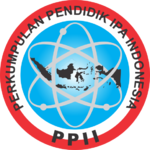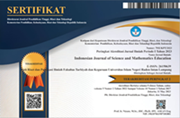AR-based interactive GeoGebra learning media for optimizing transformation geometry learning in higher education
Abstract
Keywords
Full Text:
PDFReferences
M. Bulut and R. B. Ferri, “A systematic literature review on augmented reality in mathematics education,” Eur. J. Sci. Math. Educ., vol. 11, no. 3, pp. 556-572, 2023, doi: 10.30935/scimath/13124.
N. Subani, M. Z. M. Shukri, and M. A. S. M. Nasrul, “Exploring gifted and talented muslims student’s performance using GeoGebra in teaching and learning mathematics,” Malim J. Pengaj. Umum Asia Tenggara Sea J. Gen. Stud., vol. 22, no. 1, 2021, pp. 187-196, doi: 10.17576/malim-2021-2201-23.
H. Alomyan, “The impact of distance learning on the psychology and learning of university students during the Covid-19 pandemic,” Int. J. Instr., vol. 14, no. 4, 2021, pp. 585-606, doi: 10.29333/iji.2021.14434a.
D. R. A. U. Khasanah, H. Pramudibyanto, and B. Widuroyekti, “Education in the time of the Covid-19 pandemic,” J. Sinestesia, vol. 10, no. 1, pp. 41–48, 2020.
Kemenkes, “Satukan Tekad Menuju Indonesia Sehat," www.kemkes.go.id, 2020.
K. Arizona, Z. Abidin, and R. Rumansyah, “Pembelajaran online berbasis proyek salah satu solusi kegiatan belajar mengajar di tengah pandemi Covid-19,” J. Ilm. Profesi Pendidik., vol. 5, no. 1, pp. 64–70, 2020, doi: 10.29303/jipp.v5i1.111.
D. Hariyanta, H. Hermanto, and H. Herwin, “Distance learning management in elementary schools during the pandemic,” J. Prima Edukasia, vol. 10, no. 2, pp. 123-129, 2022, doi: 10.21831/jpe.v10i2.47712.
J. Dindin, R. Teti, G. Heri, and P. Epa, “Pembelajaran daring masa pandemik Covid-19 pada calon guru : Hambatan, solusi dan proyeksi,” Karya Tulis Ilm. UIN Sunan Gunung Djjati Bdg., pp. 1–10, 2020.
B. Indrayana and A. Sadikin, “Tantangan dan solusi pembelajaran daring olahraga di masa pandemi Covid-19,” Indones. J. Sport Sci. Coach., vol. 2, no. 3, pp. 139–142, 2020, doi: 10.22437/ijssc.v2i3.10158.
M. N. Isman, “Pemanfaatan program GeoGebra dalam pembelajaran matematika,” Delta-Pi J. Mat. Dan Pendidik. Mat., vol. 5, no. 1, pp. 10–19, 2016.
A. Noornia, A. H. Wijaksana, and I. Hadi, “Mengembangkan kemampuan guru matematika melakukan penelitian tindakan kelas dengan bantuan software GeoGebra di Wilayah Tangerang Selatan,” Sarwahita, vol. 12, no. 2, pp. 102–108, 2015, doi: 10.21009/sarwahita.122.06.
B. Achmad, “Pengembangan multimedia interaktif dengan pendekatan kontekstual untuk meningkatkan kemampuan pemecahan masalah matematika,” J. Inov. Teknol. Pendidik., vol. 6, no. 1, pp. 104–115, 2019.
Z. H. Putra, N. Hermita, J. A. Alim, D. Dahnilsyah, and R. Hidayat, “GeoGebra integration in elementary initial teacher training: The Case of 3-D Shapes,” Int. J. Interact. Mob. Technol. IJIM, vol. 15, no. 19, pp. 21-32, 2021, doi: 10.3991/ijim.v15i19.23773.
S. M. Tsegay, M. A. Ashraf, S. Perveen, and M. Z. Zegergish, “Online teaching during Covid-19 pandemic: Teachers’ experiences from a Chinese University,” Sustainability, vol. 14, no. 1, pp. 1-15, 2022, doi: 10.3390/su14010568.
M. F. Salsanabila, D. E. Lestari, and D. Y. Sari, “GeoGebra as a 21st century learning tool: A systematic literature review,” J. Ilm. Profesi Pendidik., vol. 9, no. 2, pp. 989-996, 2024, doi: 10.29303/jipp.v9i2.2191.
A. Septian, “Student’s mathematical connection ability through Geogebra assisted project-based learning model,” J. Elem., vol. 8, no. 1, pp. 89-98, 2022, doi: 10.29408/jel.v8i1.4323.
D. A. Espejo-Peña and A. I. Flores-Osorio, “Modeling bounded surfaces using cylindrical coordinates using GeoGebra AR,” in International Conference on Geometry and Graphics, Springer, 2022, pp. 870–879.
A. I. Flores-Osorio and D. A. Espejo-Peña, “Design of surfaces in cylindrical coordinates using GeoGebra AR,” in International Conference on Geometry and Graphics, Springer, 2022, pp. 673–684.
M. Mailizar and R. Johar, “Exploring the potential use of GeoGebra augmented reality in a project-based learning environment: The Case of Geometry,” in Journal of Physics: Conference Series, IOP Publishing, 2021, pp. 1-8.
M. Shabanova, O. Bezumova, E. Zatsepina, S. Malysheva, S. Kotova, and R. Ovchinnikova, “Learning stereometry in a secondary school within GeoGebra’s augmented reality app,” in Journal of Physics: Conference Series, IOP Publishing, 2020, pp. 1-9.
M. Tomaschko and M. Hohenwarter, “Augmented reality in mathematics education: The case of GeoGebra AR,” in Augmented reality in educational settings, Brill, 2019, pp. 325–346.
V. Mandailina, S. Saddam, M. Ibrahim, and S. Syaharuddin, “UTAUT: Analysis of usage level of android applications as learning media in indonesian educational institutions,” IJECA Int. J. Educ. Curric. Appl., vol. 2, no. 3, pp. 16-23, 2019, doi: 10.31764/ijeca.v2i3.2080.
K. R. Ayu Kurniawati and H. R. Perwira Negara, “Worksheet persamaan differensial untuk meningkatkan kemandirian belajar mahasiswa,” JTAM J. Teori Dan Apl. Mat., vol. 3, no. 2, pp. 149-155, 2019, doi: 10.31764/jtam.v3i2.1045.
D. Dwiranata, D. Pramita, and S. Syaharuddin, “Pengembangan media pembelajaran matematika interaktif berbasis Android pada materi dimensi tiga kelas X SMA,” J. Varian, vol. 3, no. 1, pp. 1–5, 2019, doi: 10.30812/varian.v3i1.487.
R. Ziatdinov and J. Valles, “Synthesis of modeling, visualization, and programming in Geogebra as an effective approach for teaching and learning STEM topics,” Mathematics, vol. 10, no. 3, pp. 1-16, 2022, doi: 10.3390/math10030398.
D. Juandi, Y. S. Kusumah, M. Tamur, K. S. Perbowo, and T. T. Wijaya, “A meta-analysis of GeoGebra software decade of assisted mathematics learning: What to learn and where to go?,” Heliyon, vol. 7, no. 5, pp. 1-8, 2021, doi: 10.1016/j.heliyon.2021.e06953.
J. T. Asare and E. Atteh, “The impact of using Geogebra software in teaching and learning transformation (rigid motion) on senior high school students’ achievement,” Asian J. Educ. Soc. Stud., vol. 33, no. 1, pp. 36-46, 2022, doi: 10.9734/ajess/2022/v33i130784.
A. Asryana, S. Sanapiah, and I. P. Kinasih, “Pengembangan media pembelajaran interaktif menggunakan Geogebra untuk meningkatkan kemampuan spasial siswa,” Media Pendidik. Mat., vol. 5, no. 2, pp. 107-114, 2017, doi: 10.33394/mpm.v5i2.1836.
Y. Mimbadri, S. Suharto, and E. Oktavianingtyas, “Pengembangan media pembelajaran matematika interaktif online classflow berbantuan software GeoGebra pada Materi integral luas daerah,” MAJAMATH J. Mat. Dan Pendidik. Mat., vol. 2, no. 2, pp. 121-130, 2019, doi: 10.36815/majamath.v2i2.410.
N. Supriadi, “Pembelajaran geometri berbasis GeoGebra sebagai upaya meningkatkan kemampuan komunikasi matematis siswa Madrasah Tsanawiyah (MTs),” Al-Jabar J. Pendidik. Mat., vol. 6, no. 2, pp. 99–110, 2015, doi: 10.24042/ajpm.v6i2.20.
M. F. Fatoni, Dafik, and A. Fatahillah, “Pengembangan media pembelajaran interaktif kelaskita berbantuan software GeoGebra pada materi persamaan kuadrat,” J. Mat. Dan Pendidik. Mat., vol. 8, no. 2, pp. 24–33, 2017.
C. N. Zarkasyi, “Pengembangan media pembelajaran dengan Geogebra untuk visualisasi penggunaan integral pada siswa SMA,” Semin. Nas. Mat. Dan Pendidik. Mat. UNY 2015, vol. 1, no. 16, pp. 283–290, 2015.
N. V. Osypova and V. I. Tatochenko, “Improving the learning environment for future mathematics teachers with the use application of the dynamic mathematics system GeoGebra AR,” CEUR Workshop Proc., vol. 2898, no. 1, pp. 178–196, 2021.
Y. A. Wassie and G. A. Zergaw, “Some of the potential affordances, challenges and limitations of using GeoGebra in mathematics education,” Eurasia J. Math. Sci. Technol. Educ., vol. 15, no. 8, pp. 1-11, 2019, doi: 10.29333/ejmste/108436.
A. Tatarczak and M. Mędrek, “Educational experience in teaching mathematics online: A case study on the implementation of Geogebra in an interactive learning environment,” INTED2017 Proc., vol. 1, no. 1, pp. 5416–5424, 2017, doi: 10.21125/inted.2017.1262.
T. Kramarenko, O. Pylypenko, and O. Serdiuk, “Digital technologies in specialized mathematics education: Application of Geogebra in stereometry teaching,” vol. 1, no. 1, pp. 576–589, 2022, doi: 10.5220/0010926300003364.
M. Dockendorff and H. Solar, “ICT integration in mathematics initial teacher training and its impact on visualization: The case of GeoGebra,” Int. J. Math. Educ. Sci. Technol., vol. 49, no. 1, pp. 66–84, 2018, doi: 10.1080/0020739X.2017.1341060.
A. I. Suryani, Anwar, Hajidin, and I. Rofiki, “The practicality of mathematics learning module on triangles using GeoGebra,” J. Phys. Conf. Ser., vol. 1470, no. 1, 2020, pp. 1-6, doi: 10.1088/1742-6596/1470/1/012079.
DOI: http://dx.doi.org/10.24042/ijsme.v7i3.21345
Refbacks
- There are currently no refbacks.
Copyright (c) 2024 Unit Riset dan Publikasi Ilmiah FTK UIN Raden Intan Lampung

This work is licensed under a Creative Commons Attribution-ShareAlike 4.0 International License.

Indonesian Journal of Science and Mathematics Education is licensed under a Creative Commons Attribution-ShareAlike 4.0 International License.




